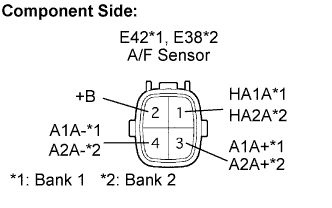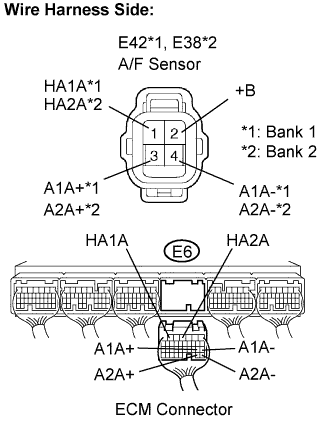CHECK ANY OTHER DTCS OUTPUT (IN ADDITION TO DTC P2A00 AND/OR P2A03)
INSPECT AIR FUEL RATIO SENSOR (HEATER RESISTANCE)
CHECK HARNESS AND CONNECTOR (A/F SENSOR - ECM)
PERFORM CONFIRMATION DRIVING PATTERN
CHECK WHETHER DTC OUTPUT RECURS (DTC P2A00 AND/OR P2A03)
PERFORM CONFIRMATION DRIVING PATTERN
CHECK WHETHER DTC OUTPUT RECURS (DTC P2A00 AND/OR P2A03)
DTC P2A00 A/F Sensor Circuit Slow Response (Bank 1 Sensor 1) |
DTC P2A03 A/F Sensor Circuit Slow Response (Bank 2 Sensor 1) |
DESCRIPTION
- HINT:
- DTC P2A00 indicates malfunctions related to the bank 1 A/F sensor.
- DTC P2A03 indicates malfunctions related to the bank 2 A/F sensor.
- Bank 1 refers to the bank that includes cylinder No. 1.
- Bank 2 refers to the bank that includes cylinder No. 2.
- Sensor 1 refers to the sensor mounted in front of the Three-Way Catalytic Converter (TWC) and located near the engine assembly.
| DTC No. | DTC Detection Conditions | Trouble Area |
| P2A00 P2A03 | Calculated value for air-fuel ratio (A/F) sensor response rate deterioration level is less than threshold |
|
WIRING DIAGRAM
Refer to DTC P2195 (Click here).INSPECTION PROCEDURE
- HINT:
- Intelligent tester only:
- Malfunctioning areas can be identified by performing the Control the Injection Volume for A/F Sensor function provided in the Active Test. The Control the Injection Volume for A/F Sensor function can help to determine whether the Air-fuel Ratio (A/F) sensor, Heated Oxygen (HO2) sensor and other potential trouble areas are malfunctioning.
- Connect the intelligent tester to the DLC3.
- Start the engine and turn the tester ON.
- Warm up the engine at an engine speed of 2,500 rpm for approximately 90 seconds.
- On the intelligent tester, enter the following menus: Power train / Engine / Active Test / Control the Injection Volume for A/F Sensor.
- Perform the Control the Injection Volume for A/F Sensor operation with the engine in an idling condition (press the RIGHT or LEFT button to change the fuel injection volume).
- Monitor the output voltages of the A/F and HO2 sensors (AFS B1 S1 and O2S B1 S2 or AFS B2 S1 and O2S B2 S2) displayed on the tester.
- HINT:
- The A/F CONTROL operation lowers the fuel injection volume by 12.5 % or increases the injection volume by 25 %.
- Each sensor reacts in accordance with increases in the fuel injection volume.
| Tester Display (Sensor) | Injection Volume | Status | Voltage |
| AFS B1 S1 or AFS B2 S1 (A/F) | +25 % | Rich | Less than 3.0 |
| AFS B1 S1 or AFS B2 S1 (A/F) | -12.5 % | Lean | More than 3.35 |
| O2S B1 S2 or O2S B2 S2 (HO2) | +25 % | Rich | More than 0.55 |
| O2S B1 S2 or O2S B2 S2 (HO2) | -12.5 % | Lean | Less than 0.4 |
- NOTICE:
- The Air-Fuel Ratio (A/F) sensor has an output delay of a few seconds and the Heated Oxygen (HO2) sensor has a maximum output delay of approximately 20 seconds.
| Case | A/F Sensor (Sensor 1) Output Voltage | HO2 Sensor (Sensor 2) Output Voltage | Main Suspected Trouble Area | ||
| 1 | Injection Volume +25 % -12.5 % |  | Injection Volume +25 % -12.5 % |  | - |
| Output Voltage More than 3.35 V Less than 3.0 V |  | Output Voltage More than 0.55 V Less than 0.4 V |  | ||
| 2 | Injection Volume +25 % -12.5 % |  | Injection Volume +25 % -12.5 % |  |
|
| Output Voltage Almost no reaction |  | Output Voltage More than 0.55 V Less than 0.4 V |  | ||
| 3 | Injection Volume +25 % -12.5 % |  | Injection Volume +25 % -12.5 % |  |
|
| Output Voltage More than 3.35 V Less than 3.0 V |  | Output Voltage Almost no reaction |  | ||
| 4 | Injection volume +25 % -12.5 % |  | Injection Volume +25 % -12.5 % |  |
|
| Output Voltage Almost no reaction |  | Output Voltage Almost no reaction |  | ||
- Following the A/F CONTROL procedure enables technicians to check and graph the voltage outputs of both the A/F and HO2 sensors.
- The following A/F Control procedure enables the technician to check and graph the voltage output of both the heated oxygen sensors. To display the graph, select the following menu items on the tester: View / Line Graph.
- HINT:
- DTC P2A00 or P2A03 may be also set, when the air-fuel ratio is stuck rich or lean.
- A low A/F sensor voltage could be caused by a rich air-fuel mixture. Check for conditions that would cause the engine to run rich.
- A high A/F sensor voltage could be caused by a lean air-fuel mixture. Check for conditions that would cause the engine to run lean.
- Read freeze frame data using the intelligent tester. Freeze frame data records the engine conditions when malfunctions are detected. When troubleshooting, freeze frame data can help determine if the vehicle was running or stopped, if the engine was warmed up or not, if the air-fuel ratio was lean or rich, and other data from the time the malfunction occurred (Click here).
| 1.CHECK ANY OTHER DTCS OUTPUT (IN ADDITION TO DTC P2A00 AND/OR P2A03) |
Connect the intelligent tester to the DLC3.
Turn the engine switch on (IG).
Turn the tester ON.
Enter the following menus: Power train / Engine / DTC.
Read DTCs.
- Result:
Display (DTC Output) Proceed to P2A00 and/or P2A03 A P2A00 and/or P2A03 and other DTCs B
- HINT:
- If any DTCs other than P2A00 or P2A03 are output, troubleshoot those DTCs first.
|
| ||||
| A | |
| 2.INSPECT AIR FUEL RATIO SENSOR (HEATER RESISTANCE) |
Disconnect the E42 or E38 A/F sensor connector.
 |
Measure the resistance of the A/F sensor connector.
- Standard resistance (Bank 1 sensor 1):
Tester Connection Condition Specified Condition HA1A (1) - +B (2) 20°C (68°F) 1.8 Ω to 3.4 Ω HA1A (1) - A1A- (4) - 10 kΩ or higher
- Standard resistance (Bank 2 sensor 1):
Tester Connection Condition Specified Condition HA2A (1) - +B (2) 20°C (68°F) 1.8 Ω to 3.4 Ω HA2A (1) - A2A- (4) - 10 kΩ or higher
Reconnect the A/F sensor connector.
|
| ||||
| OK | |
| 3.CHECK HARNESS AND CONNECTOR (A/F SENSOR - ECM) |
Disconnect the E42 or E38 A/F sensor connector.
 |
Turn the engine switch on (IG).
Measure the voltage between the +B terminal of the A/F sensor connector and body ground.
- Standard voltage:
Tester Connection Specified Condition +B (E42-2) - Body ground 9 to 14 V +B (E38-2) - Body ground 9 to 14 V
Turn the engine switch off.
Disconnect the E6 ECM connector.
Measure the resistance of the wire harness side connector.
- Standard resistance (Check for open):
Tester Connection Specified Condition HA1A (E42-1) - HA1A (E6-6) Below 1 Ω A1A+ (E42-3) - A1A+ (E6-18) Below 1 Ω A1A- (E42-4) - A1A- (E6-17) Below 1 Ω HA2A (E38-1) - HA2A (E6-4) Below 1 Ω A2A+ (E38-3) - A2A+ (E6-28) Below 1 Ω A2A- (E38-4) - A2A- (E6-27) Below 1 Ω
- Standard resistance (Check for short):
Tester Connection Specified Condition HA1A (E42-1) or HA1A (E6-6) - Body ground 10 kΩ or higher A1A+ (E42-3) or A1A+ (E6-18) - Body ground 10 kΩ or higher A1A- (E42-4) or A1A- (E6-17) - Body ground 10 kΩ or higher HA2A (E38-1) or HA2A (E6-4) - Body ground 10 kΩ or higher A2A+ (E38-3) or A2A+ (E6-28) - Body ground 10 kΩ or higher A2A- (E38-4) or A2A- (E6-27) - Body ground 10 kΩ or higher
Reconnect the ECM connector.
Reconnect the A/F sensor connector.
|
| ||||
| OK | |
| 4.PERFORM CONFIRMATION DRIVING PATTERN |
| NEXT | |
| 5.CHECK WHETHER DTC OUTPUT RECURS (DTC P2A00 AND/OR P2A03) |
Read DTCs using the intelligent tester.
Enter the following menus: Power train / Engine / DTC.
- Result:
Display (DTC Output) Proceed to P2A00 and/or P2A03 A No output B
|
| ||||
| A | |
| 6.REPLACE AIR FUEL RATIO SENSOR |
| NEXT | |
| 7.PERFORM CONFIRMATION DRIVING PATTERN |
| NEXT | |
| 8.CHECK WHETHER DTC OUTPUT RECURS (DTC P2A00 AND/OR P2A03) |
Read DTCs using the intelligent tester.
Enter the following menus: Power train / Engine / DTC.
- Result:
Display (DTC Output) Proceed to No output A P2A00 and/or P2A03 B
|
| ||||
| A | ||
| ||